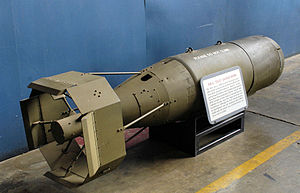The VB-6 Felix was a precision-guided munition developed by the United States during World War II. It used an infrared seeker to attack targets like blast furnaces or the metal roofs of large factories. The war ended before it could be used operationally.
| VB-6 Felix | |
|---|---|
 VB-6 Felix at the National Museum of the USAF | |
| Type | anti-ship missile / guided bomb |
| Place of origin | United States |
| Service history | |
| In service | never used operationally |
| Wars | World War II |
| Production history | |
| Designer | National Defense Research Committee |
| Produced | 1945 |
| Specifications | |
| Mass | 1202 lb (545 kg) |
| Length | 91.2 in (231.6 cm) |
| Diameter | 18.6 in (47.2 cm) |
| Warhead | amatol explosive |
| Warhead weight | 1000 pounds (454 kg) |
| Engine | none |
Guidance system | infrared |
History edit
Created by the National Defense Research Committee, Felix relied on infrared to detect and home on heat-emitting targets in clear weather;[1] blast furnaces were considered a particularly practical target for such a weapon, as were the reflective metal roofs of factory buildings.[2] It was this property which earned the weapon its name, after the ability of cats to see in the dark; Felix the Cat was an extremely popular cartoon character at the time.
Felix was a 1000-pound (454 kg) general purpose (GP) bomb with an infrared seeker in the nose and octagonal guidance fins in the tail. Unlike other weapons, such as the German Fritz X, Felix was autonomous once launched, although there was a flare in the tail for tracking. In tests, Felix demonstrated a circular error probable of 85 feet (26 m).[3]
Successful trials led to Felix being put in production in 1945, but the Pacific War ended before it entered combat.[4]
Dove edit
A naval version of the Felix, the ASM-N-4 Dove, was approved in 1944; in 1946 the project was transferred to Eastman Kodak, and in 1949 a contract for 20 prototype weapons was issued. Dove's infrared seeker was expected to be capable of correcting 400-metre (1,300 ft) aiming errors; trials took place through 1952, but no production was undertaken.[5]
See also edit
References edit
- Citations
- ^ Ordway and Wakeford 1960, p.124.
- ^ "VB-6 Felix Guided Bomb". National Museum of the United States Air Force. 8 June 2015. Retrieved 2017-12-07.
- ^ Gunston 1988, p.30.
- ^ Parsch 2003a
- ^ Parsch 2003b
- ^ Final Former Camp Wellfleet Engineering Evaluation/Cost Analysis. Prepared by Foster Wheeler Environmental Corporation, May 2000, for U.S Army Engineering and Support Center, Huntsville, Alabama.
- Bibliography
- Gunston, Bill (1988). The Illustrated Encyclopedia of Aircraft Armament. New York: Orion Books. ISBN 0-517-56607-9.
- Parsch, Andreas (9 February 2003). "VB Series (VB-1 through VB-13)". Directory of U.S. Military Rockets and Missiles, Appendix 1: Early Missiles and Drones. Designation-Systems. Retrieved 2017-12-07.
- Parsch, Andreas (22 January 2003). "Eastman Kodak ASM-N-4 Dove". Directory of U.S. Military Rockets and Missiles, Appendix 1: Early Missiles and Drones. Designation-Systems. Retrieved 2017-12-07.
- Ordway, Frederick Ira; Ronald C. Wakeford (1960). International Missile and Spacecraft Guide. New York: McGraw-Hill. ASIN B000MAEGVC.
External links edit
- Media related to VB-6 Felix at Wikimedia Commons